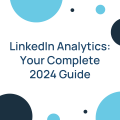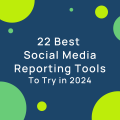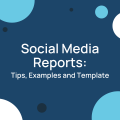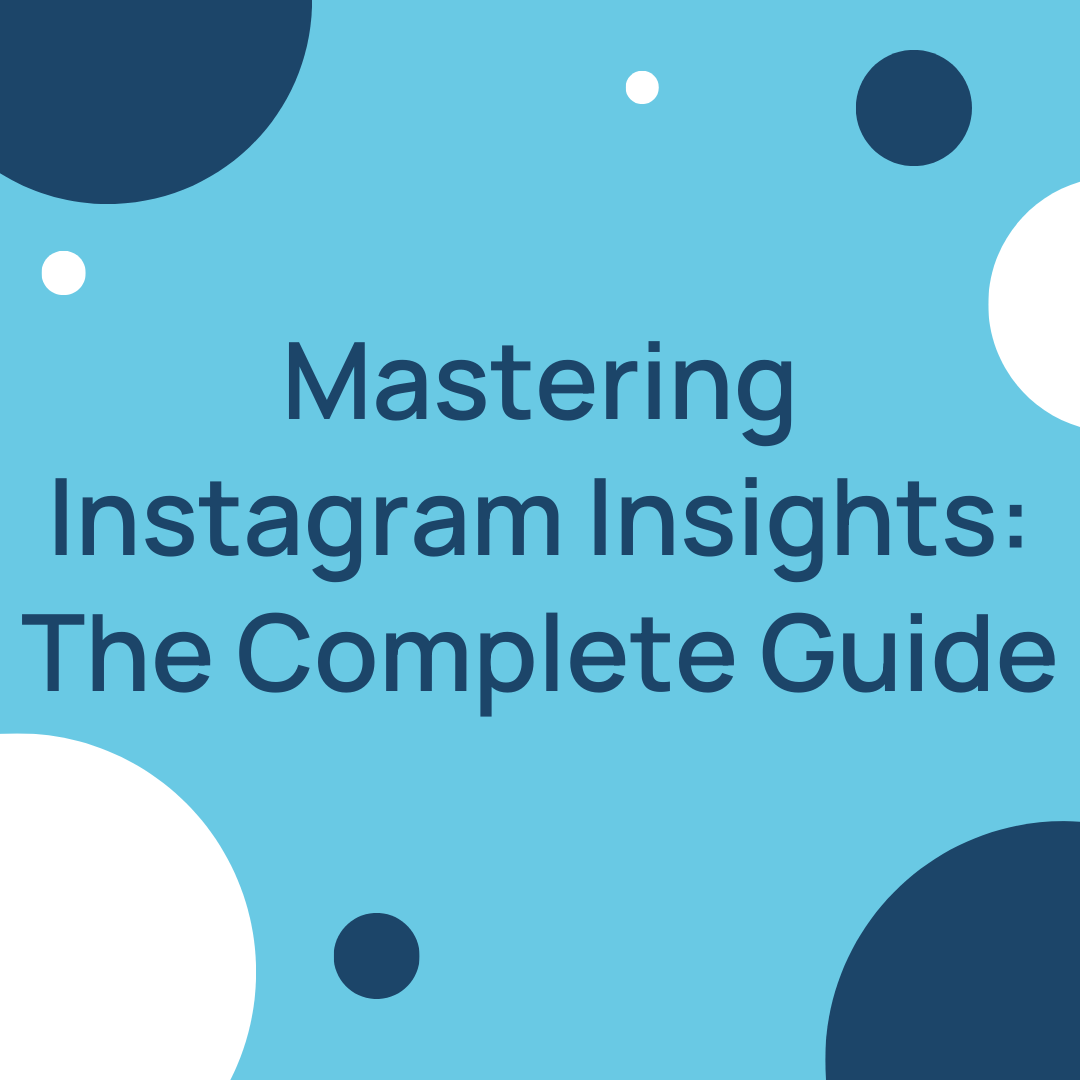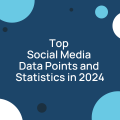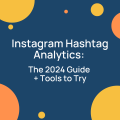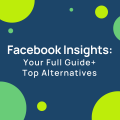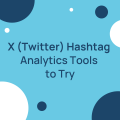Facebook Is Growing But The Engagement Is At An All-Time Low
Tina Ahmed posted on 20 February 2017
Welcome to our first Facebook monthly growth and engagement study of the year 2017!
If you missed it, do take a look at our month-by-month report of the performance in the year 2016.
In this post, we’ll focus on the latest news and updates, and on the numbers from the month of January 2017. Let’s get started.

Growth and engagement in January 2016
Facebook continues to be a challenging platform for brands looking for organic results. Page likes growth in January was at 0.13%. This is a 23.08% boost compared to the growth in December. Post reach was at 8.92% of the page audience. It’s a 9.53% decrease in reach compared to December.
Engagement rate was at 4.32% of the audience reached. This is the lowest engagement rate we’ve since on Facebook since we started doing our studies in May 2015.
Video was the post format with the highest organic reach at 12.49% of the page audience. Photos reached 10.18%, links 7.21%, and status updates reached 5.33% of the audience.
Video was also the most engaging post format with the ER of 5.14%. Status updates were second best with 4.36%, links thirds with 4.25%, and images last with the engagement rate of 4.21% of people reached.
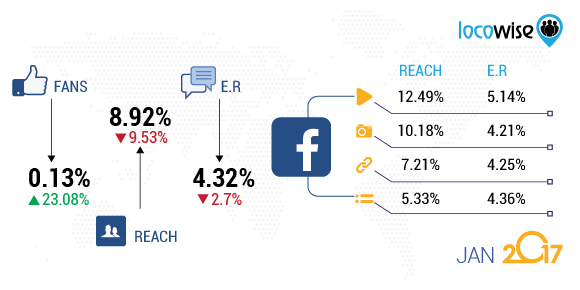
The lesson here for brands looking to get organic results is that videos rule. Posting videos rather than other formats not only gives you more organic reach but you also get more engagement.
Paid advertising was used by 14.52% of the pages with 22.43% of the total reach being paid for.
Fourth Quarter 2016 Results
Facebook reported results for a great fourth quarter of the year 2016. $8.81 billion revenue, 1.86 billion monthly active users and 1.23 billion daily actives. Mobile advertising accounts for 84% of total revenue.
Future looks bright for Facebook
That’s according to the analysts from Pacific Crest who talked about Facebook’s opportunity in broadcasting video and in introducing advertising into Facebook Messenger and WhatsApp: “We believe Facebook is still in the relatively early stages of monetizing its unique position. This combination drives extraordinary consumer engagement and makes Facebook a global clearing house for interactions between consumers and businesses of all sizes. We believe Facebook’s extraordinary share of total internet users and incredible engagement are sustainable, and solidify it as one of the most important links between consumers and businesses of all sizes around the globe.”
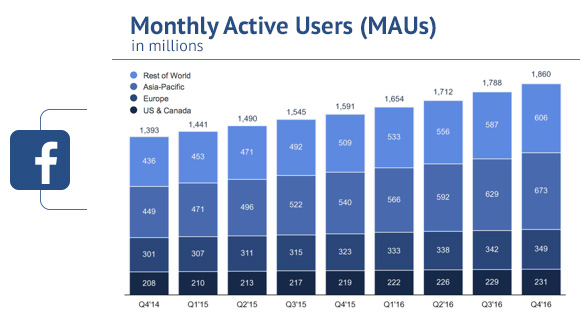
News feed style advertising is already being tested in Facebook Messenger in Australia and Thailand. This is big news for brands and is a great opportunity to reach an audience, but it remains to be seen how the users will react.
Facebook Live improvements
Over the recent weeks, Facebook worked on enabling users to broadcast live in even more formats.
Pages can now broadcast from laptop and desktop computers and there’s a permanent URL for all your videos: facebook.com/pagenamehere/videos. 360 Video is being tested and is expected to be enabled for all profiles and pages early this year. Live audio broadcasts are being tested too with selected pages and partners. This one will be very interesting for brands running podcasts and interviews. The feature will become available globally early this year too.
As live broadcasts are becoming more of a regularly used part of the platform by regular users, it looks like Facebook will stop paying influencers and other publishers for using Live.
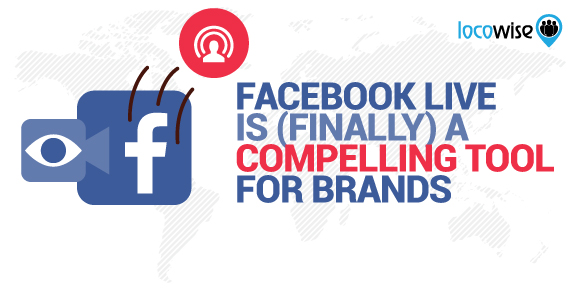
The company has spent more than $50 million last year getting celebrities and brands to broadcast live on their pages, but it doesn’t look that the soon-expiring deals for live streaming will be renewed.
Facebook Page video ads for longer videos
Next step on the list for Facebook seems to be more Netflix-like premium, high-quality, long-form video shows.
Facebook is testing mid-roll ads in videos too. These appear only in videos that last longer than 90 seconds, and display after a user has watched a video for 20 seconds. Facebook is selling the advertising, and the company is sharing 55% of the revenue with the publishers. This is the exact same split as YouTube is using.
With the 90 second rule in place, it’s pretty clear that Facebook is moving from the “view” metric into the actual stickiness of the content and the viewing time. The news feed algorithm has been updated to include the percentage of the video watched as one of the main metrics. We will see these longer-form videos also get a priority in the news feed algorithm compared to videos that last less than 90 seconds. Some publishers have seen a decline in the views they get on short-form videos:
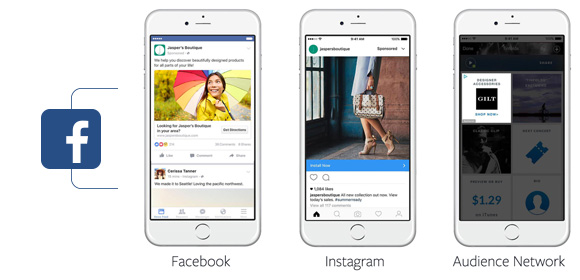
“Publishers are finding short-form video viewing figures on Facebook have plummeted as more content creators battle for space in the news feed. Over six months ago a well-performing video from The Sun would fetch 250,000 views; now it’s lucky to get over 100,000. In 2016, The Telegraph was getting over 10 million Facebook views a week for 70 videos; now it’s under 5 million. “It’s questionable whether any reduction in views is down to saturation, algorithm changes or changes in content”.”
In other video news, automatic video captioning has been released to all Facebook Pages in the English language. Look for the “generate” button when uploading a video to instantly add subtitles. This will help brands give better context to their videos in the new silent movie era.
Facebook vs Google for advertising in 2017
Some interesting findings from the new Advertiser Perceptions survey: “Two-thirds of those surveyed said they are questioning their investment with Facebook, with 40% of those saying they plan to execute independent audits of the social media platform’s audience and ad delivery. 40% of advertisers said they plan to spend more in 2017 with Facebook and Google, only 8% said they’d spend more with Facebook but not Google, compared with 36% that said they’d spend more with Google but not Facebook.”
To make their ad product even more interesting to brands, Facebook has expanded the retargeting pool to include people that like Facebook pages of other brands, interact with other Facebook ads, and also people who are visiting other brand’s sites and apps. Before this change, the advertisers could only retarget people that visited their sites, and this is a big change that has potential to put the advertisers in front of a whole new audience of highly qualified leads.

There are brands who don’t see this as the most attractive idea: “If brands don’t want their rivals to have the opportunity to advertise to people who browsed a brand’s own site or app, they can opt out of it, but only if they opt out of using Facebook’s Dynamic Ads themselves by removing Facebook’s tracking pixel from the brand’s own site and disabling Facebook’s ability to record app events in their mobile app.”
What can you expect Facebook to work on this year?
According to Andrew Bosworth, head of advertising:
Facebook should help people directly order food, buy tickets to events, find out what to do on a Saturday night and shop until their heart’s content straight from the app. Some of this has already begun, as Facebook integrates chatbots that help people order things through third-party partners. Others have begun to bubble up organically, such as people using Facebook’s recommendations service to solicit ideas from friends in any given city. “I think 2017 is going to be a time to chip away at all these daily annoyances we all have that should be a lot easier. All these little things that are just dingy little annoyances should be a lot better, and we’re going to start chipping away at those. And it’s not just use, but as an industry we’re trying to finally make these devices live up to their potential.”
Bosworth also wants brands to improve their targeting and the creative content they use in their advertising: “At the end of the day, our ability to drive results is only as good as the creative we get and only as good as the audience we’re given to target. I think what you heard from Sony is that instead of just trying one true creative marketers should be trying lots of creative and lots of different things, with lots of different audiences. And then as a second step, they should see what’s resonating and then double down and then and see what’s not and trim back on that.”

